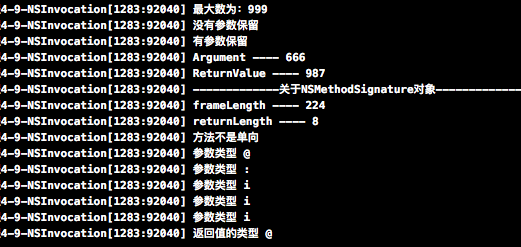一. NSInvocation简介
在iOS开发中,可以直接调用方法的方式有两种:performSelector:withObject: 和 NSInvocation。
performSelector:withObject:使用简单,但缺点是只能传一个参数,大于2个参数就无法使用;NSInvocation就不一样,功能更加强大,但实现有点复杂。在IOS4.0之后,这两种直接调用对象消息的方法,大多被block结构所取代,只有在很老的兼容性系统中才会使用。
NSInvocation是一个消息调用类,它包含了所有OC消息的成分:target、selector、参数以及返回值。NSInvocation可以将消息转换成一个对象,消息的每一个参数能够直接设定,而且当一个NSInvocation对象调度时返回值是可以自己设定的。一个NSInvocation对象能够重复的调度不同的目标(target),而且它的selector也能够设置为另外一个方法签名。NSInvocation遵守NSCoding协议,但是仅支持NSPortCoder编码,不支持归档型操作。
提示:在面向对象中,方法也称消息。
二. NSInvocation的接口
@interface NSInvocation : NSObject {
@private
__strong void *_frame;
__strong void *_retdata;
id _signature;
id _container;
uint8_t _retainedArgs;
uint8_t _reserved[15];
}
// 通过NSMethodSignature对象创建NSInvocation对象,NSMethodSignature为方法签名类
+ (NSInvocation *)invocationWithMethodSignature:(NSMethodSignature *)sig;
// 获取NSMethodSignature对象
@property (readonly, retain) NSMethodSignature *methodSignature;
// 保留参数,它会将传入的所有参数以及target都retain一遍
- (void)retainArguments;
// 判断参数是否还存在
// 调用retainArguments之前,值为NO,调用之后值为YES
@property (readonly) BOOL argumentsRetained;
// 设置消息调用者,注意:target最好不要是局部变量
@property (nullable, assign) id target;
// 设置要调用的消息
@property SEL selector;
// 获取消息返回值
- (void)getReturnValue:(void *)retLoc;
// 设置消息返回值
- (void)setReturnValue:(void *)retLoc;
// 获取消息参数
- (void)getArgument:(void *)argumentLocation atIndex:(NSInteger)idx;
// 设置消息参数
- (void)setArgument:(void *)argumentLocation atIndex:(NSInteger)idx;
// 发送消息,即执行方法
- (void)invoke;
// target发送消息,即target执行方法
- (void)invokeWithTarget:(id)target;
@end三. NSMethodSignature的接口
@interface NSMethodSignature : NSObject {
@private
void *_private;
void *_reserved[6];
}
// 通过Objective-C类型编码(Objective-C Type Encodings)创建一个NSMethodSignature对象
+ (nullable NSMethodSignature *)signatureWithObjCTypes:(const char *)types;
// 方法参数个数
@property (readonly) NSUInteger numberOfArguments;
// 获取参数类型
- (const char *)getArgumentTypeAtIndex:(NSUInteger)idx NS_RETURNS_INNER_POINTER;
// 获取方法的长度
@property (readonly) NSUInteger frameLength;
// 是否是单向
- (BOOL)isOneway;
// 获取方法返回值类型
@property (readonly) const char *methodReturnType NS_RETURNS_INNER_POINTER;
// 获取方法返回值的长度
@property (readonly) NSUInteger methodReturnLength;
@end四. NSInvocation的使用方法
(一). 使用步骤
根据方法创建签名对象(NSMethodSignature对象)
根据签名对象创建调用对象(NSInvocation对象)
设置调用对象(NSInvocation对象)的相关信息
调用方法
获取方法返回值
(二). 具体实现
1. 调用无参无返回值的方法
- (void)invocation1 {
// 1. 根据方法创建签名对象sig
NSMethodSignature *sig = [[self class] instanceMethodSignatureForSelector:@selector(method)];
// 2. 根据签名对象创建调用对象invocation
NSInvocation *invocation = [NSInvocation invocationWithMethodSignature:sig];
// 3. 设置调用对象的相关信息
// 注意:target不要设置成局部变量
invocation.target = self;
invocation.selector = @selector(method);
//4. 调用方法
[invocation invoke];
}
- (void)method {
NSLog(@"无参无返回值");
}2. 调用有参无返回值的方法
- (void)invocation2 {
// 1. 根据方法创建签名对象sig
NSMethodSignature *sig = [[self class] instanceMethodSignatureForSelector:@selector(methodWithArg1:arg2:)];
// 2. 根据签名对象创建调用对象invocation
NSInvocation *invocation =[NSInvocation invocationWithMethodSignature:sig];
// 3. 设置调用对象的相关信息
invocation.target = self;
invocation.selector = @selector(methodWithArg1:arg2:);
NSString *name = @"SJM";
int age = 18;
// 参数必须从第2个索引开始,因为前两个已经被target和selector使用
[invocation setArgument:&name atIndex:2];
[invocation setArgument:&age atIndex:3];
// 4. 调用方法
[invocation invoke];
}
- (void)methodWithArg1:(NSString *)arg1 arg2:(int)arg2 {
NSLog(@"我叫%@,今年%d岁。", arg1, arg2);
}3. 调用有参有返回值的方法
- (void)invocation3 {
// 1. 根据方法创建签名对象sig
NSMethodSignature *sig = [[self class] instanceMethodSignatureForSelector:@selector(methodWithArg1:arg2:arg3:)];
// 2. 根据签名对象创建调用对象invocation
NSInvocation *invocation = [NSInvocation invocationWithMethodSignature:sig];
// 3. 设置调用对象的相关信息
invocation.target = self;
invocation.selector = @selector(methodWithArg1:arg2:arg3:);
int value1 = 111;
int value2 = 999;
int value3 = 666;
[invocation setArgument:&value1 atIndex:2];
[invocation setArgument:&value2 atIndex:3];
[invocation setArgument:&value3 atIndex:4];
// 4. 调用方法
[invocation invoke];
// 5. 获取方法返回值
NSNumber *num = nil;
[invocation getReturnValue:&num];
NSLog(@"最大数为:%@",num);
}
- (NSNumber *)methodWithArg1:(int)arg1 arg2:(int)arg2 arg3:(int)arg3 {
int max1 = MAX(arg1, arg2);
int max2 = MAX(arg2, arg3);
// 返回最大数
return @(MAX(max1, max2));
}4. NSInvocation的其他属性与方法
- (void)invocation4 {
// 1. 根据方法创建一个签名对象sig
NSMethodSignature *sig = [[self class] instanceMethodSignatureForSelector:@selector(methodWithArg1:arg2:arg3:)];
// 2. 根据签名对象创建调用对象invocation
NSInvocation *invocation = [NSInvocation invocationWithMethodSignature:sig];
// 3. 设置调用对象的相关信息
invocation.target = self;
invocation.selector = @selector(methodWithArg1:arg2:arg3:);
int value1 = 111;
int value2 = 999;
int value3 = 666;
[invocation setArgument:&value1 atIndex:2];
[invocation setArgument:&value2 atIndex:3];
[invocation setArgument:&value3 atIndex:4];
// 4. 调用方法,也可以使用invokeWithTarget:方法指定调用者
[invocation invoke];
// 5. 获取方法返回值
NSNumber *num = nil;
[invocation getReturnValue:&num];
NSLog(@"最大数为:%@",num);
/* -------------------------------分隔线---------------------------------- */
// NSInvocation的其他属性
// argumentsRetained属性是判断参数是否还存在
// 调用retainArguments之前,值为NO,调用之后值为YES
NSLog(@"%@参数保留", (invocation.argumentsRetained ? @"有" : @"没有"));
[invocation retainArguments];
NSLog(@"%@参数保留", (invocation.argumentsRetained ? @"有" : @"没有"));
// 获取参数值
if (invocation.argumentsRetained) {
int arg;
[invocation getArgument:&arg atIndex:4];
NSLog(@"Argument ---- %d",arg);
}
// 设置方法返回值
NSNumber *value = @987;
[invocation setReturnValue:&value];
[invocation getReturnValue:&value];
NSLog(@"ReturnValue ---- %@",value);
// 关于NSMethodSignature对象
NSLog(@"-------------关于NSMethodSignature对象---------------");
[self methodSignature:invocation];
}
- (NSNumber *)methodWithArg1:(int)arg1 arg2:(int)arg2 arg3:(int)arg3 {
int max1 = MAX(arg1, arg2);
int max2 = MAX(arg2, arg3);
// 返回最大数
return @(MAX(max1, max2));
}
// NSMethodSignature的使用
- (void)methodSignature:(NSInvocation *)invocation {
// 获取方法签名对象
NSMethodSignature *signature = invocation.methodSignature;
// 获取方法所占字节数
NSUInteger frameLength = signature.frameLength;
NSLog(@"frameLength ---- %ld",frameLength);
// 获取方法返回值所占字节数
// 这里只对数值型的类型有效,OC类型打印都是8字节
NSUInteger returnLength = signature.methodReturnLength;
NSLog(@"returnLength ---- %ld",returnLength);
// 判断方法是否是单向
NSString *oneWay = [signature isOneway] ? @"是" : @"不是";
NSLog(@"方法%@单向", oneWay);
// 获取参数个数
NSInteger count = signature.numberOfArguments;
// 打印所有参数类型,
// 这里打印的结果是 @ : i i i 它们是Objective-C类型编码
// @ 表示 NSObject* 或 id 类型
// : 表示 SEL 类型
// i 表示 int 类型
for (int i = 0; i < (int)count; i++) {
const char *argTybe = [signature getArgumentTypeAtIndex:i];
NSLog(@"参数类型 %s",argTybe);
}
// 获取返回值的类型
const char *returnType = [signature methodReturnType];
NSLog(@"返回值的类型 %s",returnType);
}打印结果:






















 259
259











 被折叠的 条评论
为什么被折叠?
被折叠的 条评论
为什么被折叠?








